Spine | Lumbar
- CHARSPINE2 VD direct vertebral body derotation
- Instrument Set for Posterior Lumbar Spine Preparation
- Mesh VBR Implant System
- CHARSPINE2 MIS minimally invasive surgery
- ALIF PEEK intervertebral cage
- ALIF PEEK intervertebral locking cage
- TLIF PEEK intervertebral cage
- 3D-Ti TLIF intervertebral cage
- 3D-Ti PLIF intervertebral cage
- Expandable VBR implants system
- PLIF PEEK Intervertebral cage
- CHARSPINE2 spine stabilization with screws
- CHARSPINE2 VD direct vertebral body derotation
- Instrument Set for Posterior Lumbar Spine Preparation
- Mesh VBR Implant System
- CHARSPINE2 MIS minimally invasive surgery
- ALIF PEEK intervertebral cage
- ALIF PEEK intervertebral locking cage
- TLIF PEEK intervertebral cage
- 3D-Ti TLIF intervertebral cage
- 3D-Ti PLIF intervertebral cage
- Expandable VBR implants system
- PLIF PEEK Intervertebral cage
- CHARSPINE2 spine stabilization with screws

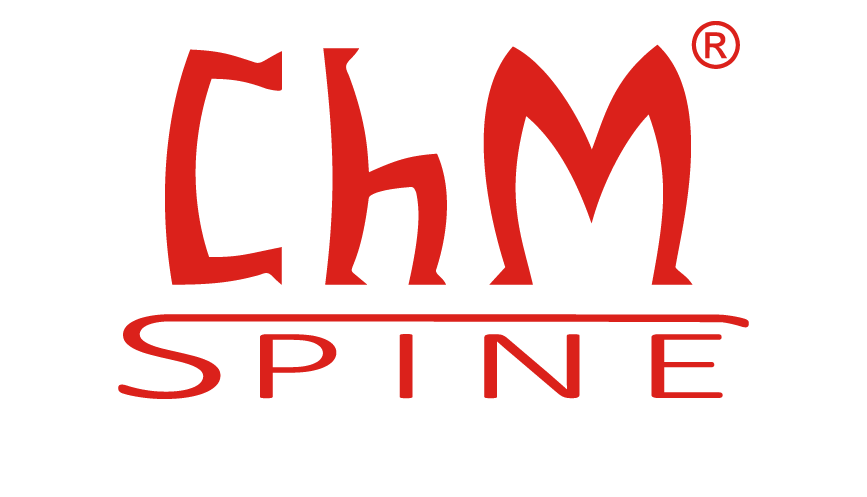
Transpedicular Systems
CHARSPINE2 VD direct vertebral body derotation
The CHARSPINE2 VD set of vertebral body derotation instrumentation, designed by the team of ChM specialists, has been developed to meet the challenges sur-geons face in the treatment of complex deformations and to broaden the application of known and clinically proven CHARSPINE2 bar stabilization system. The new system provides solutions to surgeons when treating spinal deformities (scoliosis).
CHARSPINE2 VD utilizes the direct vertebral derotation technique that allows for three-dimensional correction of spinal disorders. The system consists of sleeves and clamps that can be combined into blocks in any way ensuring the most effec-tive correction of deformity. The CHARSPINE2 VD instrument set has been especially designed for and is fully compatible with CHARSPINE2 bar stabilization system.


Interbody Devices
Instrument Set for Posterior Lumbar Spine Preparation
A set of specialized instruments that signi cantly facilitate the procedure of lumbar spine preparation from the posterior approach
- 9 types of bone rongeurs
- 10 types of bone curettes
- 2 files | 2 nerve elevators
- Vertebra elevator
- Nerve hook
- Sypert bone rongeur and osteotome
- Modern containers


Interbody Devices
Mesh VBR Implant System
- A wide range of sizes for best t to an individual patient’s anatomy at every spine level.
- Quick and safe press-fit assembly of the system elements (without additional connecting elements)
- Intuitive instruments
- Meshes can be trimmed to the appropriate height
- Simple selection of individual compatible elements based on colours
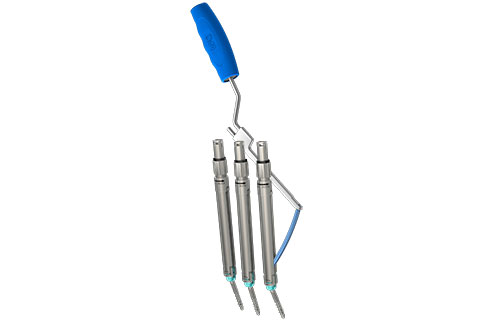


Transpedicular Systems
CHARSPINE2 MIS minimally invasive surgery
CHARSPINE2 MIS Thoracolumbar spine stabilization system is a set of implants designed for the treatment of the thoracic-lumbar spine using a minimally invasive technique. The system is used with the posterior approach (from Th1 to S1) in skeletally mature patients.


Interbody Devices
ALIF PEEK intervertebral cage
The ALIF PEEK Intervertebral Cage system consists of polietheroetheroketone (PEEK) cages of various widths, heights and angles to adapt best to variety of patients’ anatomies.
The ALIF PEEK Intervertebral Cages are designed for use with bone grafting for spondylodesis of one level or two contiguous levels of lumbar spine. Anterior, anterolateral or lateral approaches may be used. The implants are indicated for treatment of degenerative disc disease (DDD) and grade 1 spondylolisthesis in lumbar spine from L2 to S1.
The ALIF PEEK Intervertebral Cages should be used with additional stabilizing devices allowed for surgeries of lumbar spine (e.g.: a system of posterior pedicle screws and rods). Degenerative disc disease (DDD) is defined as discogenic back pain with degeneration of the disc confirmed by history and radiographic studies. Patients qualified for treatment should be skeletally mature and have had at least six months of non-operative treatment.


Interbody Devices
ALIF PEEK intervertebral locking cage
The ALIF PEEK Intervertebral Locking Cage system consists of polietheroetheroketon (PEEK) cages of various widths, heights and angles to adapt best to variety of patients’ anatomies. The ALIF PEEK Intervertebral Locking Cage is designed for use with autograft, as stand-alone device (without supplemental fixation systems) for anterior intervertebral body fusion at one level or two contiguous levels of lumbar spine.
The implants are indicated for the treatment of degenerative disc disease (DDD) and grade 1 spondylolisthesis in lumbar spine from L2 to S1. Degenerative disc disease (DDD) is defined as discogenic back pain with degeneration of the disc confirmed by history and radiographic studies. Patients qualified for treatment should be skeletally mature and have had at least six months of non-operative treatment.


Interbody Devices
TLIF PEEK intervertebral cage
TLIF Intervertebral cage system is intended for the treatment of diseases caused by disorders of the function of the intervertebral discs in the lumbar spine, at levels from L2 to S1 in skeletally mature patients. The diseases include, i.a.: degenerative disc disease (DDD), vertebral instability, spondylolisthesis, herniated discs.
TLIF Intervertebral cage system comprises cages of various widths, heights and lordotic angles to adapt best to a patient’s spinal anatomy. TLIF intervertebral cages are made of biocompatible PEEK (polyether ether ketone) polymer or biocompatible titanium alloy. For the manufacture of the latter, the additive manufacturing technique with use of Selective Laser Melting (SLM) technology (3D) is used. This technology ensures a spatial structure inside the implant for the bone tissue to overgrow the cage. TLIF Intervertebral cage system is designed for implantation via posterolateral (transforaminal) approach


Interbody Devices
3D-Ti TLIF intervertebral cage
TLIF intervertebral cages have a curved (kidney-shaped) form which facilitates the procedure of their implantation and ensures their perfect match to the curvature of the anterior walls of the vertebral bodies. The wedge shape of one of ends guarantees smooth implant insertion and positioning between the vertebral bodies. Each implant has been equipped with a special mechanism for problem-free change of the angle of the implant’s position relative to the insertion instrument (from 0° to 80° for PEEK polymer cages and up to 95° for cages made of 3D-printed titanium alloy) during the implantation procedure.
All TLIF intervertebral cages manufactured by ChM are handled with one instrument set what simplifies and reduces the costs of the procedure


Interbody Devices
3D-Ti PLIF intervertebral cage
The PLIF Cage system consists of cages of various widths, heights and lordotic angles to adapt to variety of patients’ anatomies.
PLIF intervertebral cages are made of biocompatible PEEK (polyether ether ketone) polymer, and biocompatible titanium alloy in additive manufacturing technique, by Selective Laser Melting technology (3D-Ti). The implants of PLIF Cage system are designed to be inserted bilaterally (in pairs) and are indicated for an open posterior approach for treatment of degenerative disc disease (DDD),vertebral instability, Grade 1 spondylolisthesis as well as for spine revision surgery.
The implants should be used at one or two contiguous levels from L2 to S1. DDD is defined as discogenic back pain with degeneration of the disc confirmed by history and radiographic studies. Patients qualified for treatment should be skeletally mature and have had six months of non-operative treatment.
The implants of PLIF Cage system are designed to be used with autogenous bone graft and are intended for use with supplemental fixation systems cleared for use in the lumbar spine (e.g. pedicle screw and rod systems).
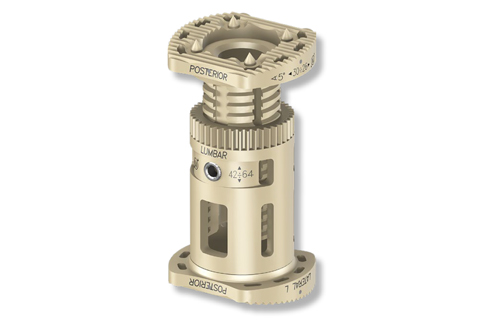

Interbody Devices
Expandable VBR implants system
The CHARSPINE VBR implant developed by the ChM, depending on the level of the treated spine segment and the surgeon’s preferences, can be introduced using anterior, anterolateral, lateral or posterior-lateral approaches. The design of the device allows for a smooth in vivo change of its height, making the implantation simple and ensuring perfect match of the implant with the patient’s anatomy.
The CHARSPINE VBR system includes a set of implants, instruments and stands. All these elements allow for friendly, simple and intuitive us, facilitating: preparation for the procedure, implantation surgery, washing and disinfection. The implants are made of the highest quality biocompatible materials – PEEK OPTIMA INVIBIO – a plastic with high biocompatibility and stiff ness similar to human bones, and metals – tantalum and titanium alloy
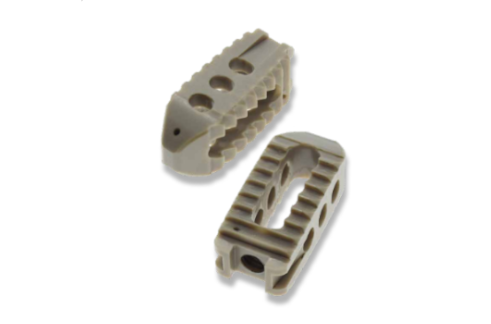

Interbody Devices
PLIF PEEK Intervertebral cage
The PLIF Cage system consists of cages of various widths, heights and lordotic angles to adapt to variety of patients’ anatomies.
PLIF intervertebral cages are made of biocompatible PEEK (polyether ether ketone) polymer, and biocompatible titanium alloy in additive manufacturing technique, by Selective Laser Melting technology (3D-Ti). The implants of PLIF Cage system are designed to be inserted bilaterally (in pairs) and are indicated for an open posterior approach for treatment of degenerative disc disease (DDD), vertebral instability, Grade 1 spondylolisthesis as well as for spine revision surgery.
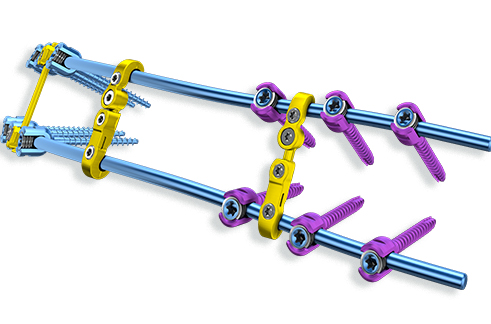

Transpedicular Systems
CHARSPINE2 spine stabilization with screws
is the universal set of implants for treatment of thoracolumbar and lumbar spine in skeletally mature patients with posterior approach (screw fixation from T1(T3) to S2 and hook fixation from T1(T3) to L5) and anterolateral approach (screw fixation from T4(T6) to L4(L3)).
Implants allow for treatment intended for spinal physiological curvature reconstruction by means of appropriate vertebrae reposition.
